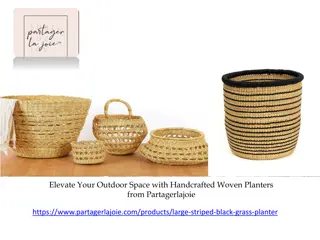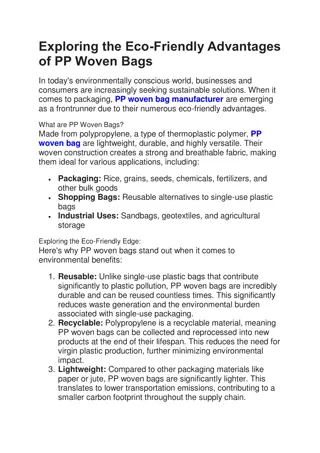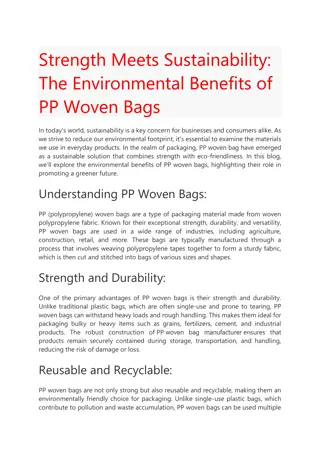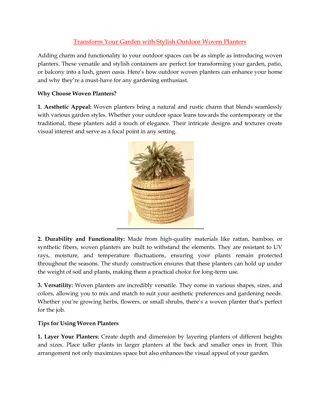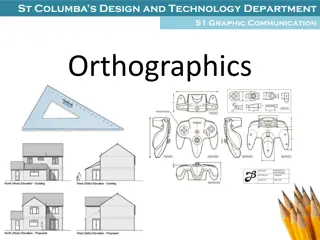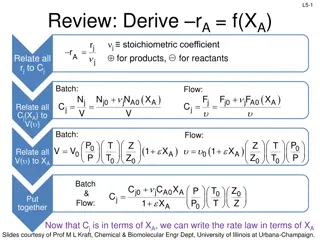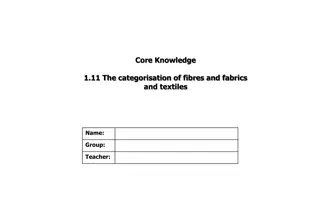Fundamentals of Woven Design Explained
Woven fabrics are created by interlacing warp and weft threads, offering diverse design possibilities. Learn about woven structures, elements of design, and the classification of woven fabrics. Discover the intricacies of design, draft plans, and peg/lifting plans essential for weaving projects.
Download Presentation

Please find below an Image/Link to download the presentation.
The content on the website is provided AS IS for your information and personal use only. It may not be sold, licensed, or shared on other websites without obtaining consent from the author.If you encounter any issues during the download, it is possible that the publisher has removed the file from their server.
You are allowed to download the files provided on this website for personal or commercial use, subject to the condition that they are used lawfully. All files are the property of their respective owners.
The content on the website is provided AS IS for your information and personal use only. It may not be sold, licensed, or shared on other websites without obtaining consent from the author.
E N D
Presentation Transcript
FUNDAMENTALS OF WOVEN DESIGN MS.K.KATHIROLI MS.K.KATHIROLI ASST PROFESSOR, ASST PROFESSOR, DEPARTMENT OF FT & CD, DEPARTMENT OF FT & CD, BON BON SECOURS SECOURS COLLEGE FOR WOMEN,THANJAVUR WOMEN,THANJAVUR COLLEGE FOR
Woven Design: Woven fabrics are made by using two or more sets of yarn interlaced at right angles to each other. Much variety is produced by weaving. Woven cloth is formed by the interlacement of two sets of threads, namely, warp and weft threads. These threads are interlaced with one another according to the type of weave or design. The warp threads are those that run longitudinally along the length of the fabric and the weft threads are those that run transversely across the fabric. For the sake of convenience , the warp threads are termed as ends and the weft as picks or fillings.
Classification of Woven Structures: Woven structures are classified into the following categories: Simple structures Compound structures Simple structures: In case of simple structures, there is only one series of warp and weft threads. These threads interlace with one another perpendicularly. All the neighboring warp and weft threads are parallel to one another and play an equally important role in determining the properties of the fabric. Compound structures: In case of compound structures, there may be more than one series threads, of which one set forms the figuring or ornamentation. Unlike the simple structures, the neighboring threads need not to be parallel to one another.
Elements of Woven Design: The three basic elements in a woven design are: DESIGN. DRAFT OR DRAWING PLAN. PEG OR LIFTING PLAN.
Design: The design indicates the interlacement of warp and weft threads in the repeat of the design. It is made up of a number of squares, which constitute the repeat size of a design. The vertical direction of the squares indicate the picks and the horizontal direction indicates the ends. A blank in a square indicates that a warp goes below the corresponding weft and X mark in the square indicates that the warp floats above the weft Draft: The draft or drawing plan indicates the manner of drawing the ends through the heald eyes and it also denotes the number of heald shaft required for a given weave repeat. The choice of the type of drafting plan depends upon the type of fabric woven.
Peg plan: The peg or lifting plan provides useful information to the weaver. It denotes the order of lifting of heald shafts. In a peg plan, the vertical spaces indicate the heald shafts and the horizontal spaces indicate the picks. The peg plan depends upon the drafting plan. In the case of a straight draft, the peg plan will be the same as the design. Hence no peg plan is necessary in the case of a straight draft.
Methods of Weave Representation: A weave is the interlacing pattern of the warp and weft. Two kinds of interlacing are possible: Warp overlap in which warp is above weft: When the warp is lifted above the inserted weft, a warp overlap is obtained. Weft overlap in which weft is above warp: When the warp thread is lowered, the weft thread is inserted above the warp thread and the weft overlap is obtained.
There are two practical methods of weave representation: Linear. Canvas. Linear Method: In linear method each warp thread is represented by a vertical line and each weft thread by a horizontal line. The point of intersection of lines corresponding to a warp overlap is marked by the dot, and the point of intersection corresponding to weft overlap remains unmarked. Though this is a simple method, it is seldom used because the designer has to draw plenty of horizontal and vertical lines, which is time consuming.
Canvas Method: In the canvas method, a squared paper is employed, on which each vertical space represents a warp thread and each horizontal space represents a weft thread. Each square therefore indicates an intersection of warp and weft thread. To show the warp overlap, a square is filled in or shaded. The blank square indicates that the weft thread is placed over the warp i.e. weft overlap. Several types of marks may be used to indicate the warp overlap. The x mark is most commonly used.
Weave Repeat: The repeat of a weave is a quantitative expression of any given weave. It indicates the minimum number of warp and weft threads for a given weave. It comprises of warp and weft repeat. The size of the repeat may be even or uneven depending upon the nature of the weave. In elementary weaves such as plain, twill, satin etc. the repeat size is normally even. However , in weaves such as honeycomb, huck a back the repeat size may be even or uneven. For any weave, the repeat size is the sum of the warp and weft floats. Thus in case of a 2/1 twill the repeat size is 3 3. It is common practice to denote one repeat of a weave on design paper. Matrix of weave repeat
Construction for elementary Weaves: The plain weave may be modified by extending it warp or weft way or both. The extension of the plain weave thus produces a rib effect. A warp rib results from extending the plain weave in the warp direction. A weft rib structure results from extending the plain weave in the weft direction. A matt rib results from extending the plain weave in both directions.
These are produced by extending the plain weave in warp way direction and can be constructed on regular and irregular basis. The warp rib is denoted by a fraction. The numerator shows the number of warp overlapping and the denominator, the number of weft overlapping on the same thread within the repeat. The sum of the fraction numerator and denominator is equal to the weft repeat. Warp Rib - Regular Weft Rib- Irregular
Weft Rib: Constructed by extending the plain weave in weft direction and can be constructed on regular and irregular basis. The sum of the fraction of numerator and denominator is equal to the warp repeat. In both the warp and weft rib weaves: The appearance of the cloth depends on the respective thread settings, and to achieve good effects, The weft rib can be enhanced with a high number of picks per inch and a comparatively low number of ends per inch. The warp rib effect can be enhanced with a high number of ends per inch and a comparatively low number of picks per inch. The prominence of the rib can be increased by suitable use of coarse and fine yarns. Rib weaves are used in extensively employed for window blinds in railway and other vehicles, and upholstering furniture.
Modification of Twills: These weaves are derived from twill weaves and retain their structural features. Twill weave can be modified, By extending the floats, By changing the shifts, By extending the float and changing the shift. Both As per the basic design of twill weave, It would have many variations and type of twill weave derivatives. It has a great potential for the introduction of ornamentation into the fabric. Herringbone Twills: This type of twill is reversed as like pointed twills. but does not come to a point where it changes the direction. This type of construction produces a distinct stripe effect, prevents the formation of an extended float where the weave turns. In this aspect the herringbone twills are considered to be more advantageous than the pointed twills.
Satin/Sateen Weave: Satin/ sateen weave is a rearranged twill weave. It is purposely interrupted in order to contribute to the smooth and lustrous surface desired. Interlacing points are arranged so as to allow the floating threads to slip and cover the binding point of one thread by the float of the other, which results maximum degree of smoothness and luster. In a true satin weave each warp and weft yarn only interlace once in each repeat of weave. Satin weave fabrics have relatively long floats. The sateen weave is denoted by a fraction. The numerator is equal to the repeat of weave. The denominator is equal to the shift (Sy) of overlaps. Satin/Sateen weave can be classified: Regular satin/sateen weave which fulfils the shift rule. Irregular satin/sateen weave which doesn t fulfill the shift rule.



